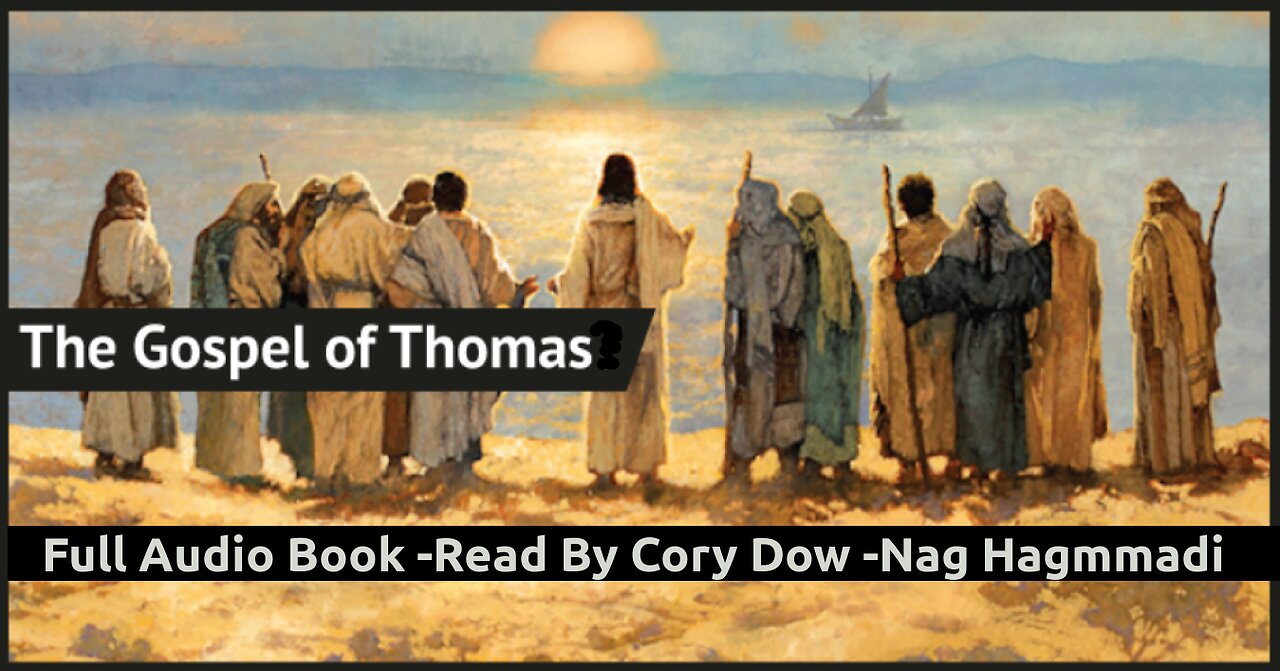Premium Only Content

The Gospel of Thomas- Read by Cory Dow - Audio Book
The full reading is here: https://youtu.be/FEW5OUBb-a4?si=7iXPpHTXbuDgUFLi and the transcript is here: https://www.marquette.edu/maqom/Gospel%20of%20Thomas%20Lambdin.pdf
The Gospel of Thomas is reminiscent of the Forgotten Books of Adam and Eve. They are both first person accounts from the times of Jesus, what was passed down from eons of stories from the times of the Garden. How we came to these stories is from Centuries of care on the part of those times as stories of Old.. which can be thought of this way.... Excellent material that move one to know more about times that are in the Cannon Bible but more personalized pieces, first person.. that create a discussion about our Christianity and a depth that stirs your soul. Are we to feel these words are authentic? They are not in the Cannon but one can feel these words. It has great value because of the discussion it creates and how it is assembled. So discuss.. this is not something to be held tight as it is from very old Gnostic Greek Texts. But it sure sounds familiar.
Jesus and the Gospel of Thomas: What Do We Know?
Discovered near the Egyptian town of Nag Hammadi in 1945, the Gospel of Thomas is likely the most famous non-canonical gospel. It contains 114 logia (or sayings) attributed to Jesus Christ in the form of parables and short dialogues with his disciples and other people.
Gregg Braden discusses the Gospel of Thomas https://youtu.be/4Z3Alt_r7ow?si=h3H_5nmsBeRM7WI9
The Gospel of Thomas has been the product of many sensationalist claims and theories. The controversial Jesus Seminar, for example, produced a book called The Five Gospels: What Did Jesus Really Say? (1993) and included Thomas alongside the canonical New Testament gospels of Matthew, Mark, Luke, and John. The Seminar treated the Gospel of Thomas as a primary and early source for learning about the historical Jesus. According to proponents of this view, Thomas was written as early, if not before, the synoptics (Mark, Matthew, and Luke) and would therefore provide an earlier or even more genuine presentation of the historical Jesus. However, this is a minority position within scholarship; New Testament scholar Dale Martin explains,
“Most scholars would say it is written before the year 200 [C.E.]. Some scholars believe that the Gospel of Thomas goes all the way back to the first century and may even be as early as Mark, Q, or even earlier. The majority of scholars don’t believe that, the majority of us believe that the Gospel of Thomas was first written in Greek in the first half of the second century, so between 100 and 150. But we don’t really know, it’s just a complete guess”.
If one accepts the majority view of a later date for this text, then it no doubt proves a valuable source for a second century version of early Christianity and how a specific group of Christians viewed the historical Jesus. But as Martin observed, we cannot have much confidence regarding date of authorship. This is because unlike the canonical gospels the Gospel of Thomas lacks historical narrative as a sayings gospel. Most scholars are able to date texts from history on the basis of their historical narrative, but this is not possible for Thomas. However, although most scholars date Thomas somewhere between 130 and 200 CE, the possibility cannot be dismissed that some of its sayings could date back to the historical Jesus. Regarding authorship, Christ’s original disciple Thomas, who is depicted in the canonical gospels (he adopts the role of an important character in a resurrection story from John but is only listed in the names of the disciples in the synoptics), did not author this text. Instead, Thomas is a later document attributed to the original disciple Thomas.
-
 12:27
12:27
JUAN O SAVIN PRESENTATIONS
4 days agoJUAN O SAVIN- We Didn't Start the Fire Future Proves Past?- NINO 11 1 2025
12.9K4 -

vivafrei
2 hours agoArctic Frost is Bigger Scandal than you Think!! Live with Former Green Beret Ivan Raiklin!
21.1K15 -
 LIVE
LIVE
Turning Point USA
1 hour agoTPUSA Presents This Is the Turning Point Tour LIVE with Eric and Lara Trump at Auburn University!
1,692 watching -
 1:01:50
1:01:50
MattMorseTV
2 hours ago🔴Now he’s literally BEGGING for a DEAL. 🔴
10.1K14 -
 LIVE
LIVE
SpartakusLIVE
3 hours agoBattlefield 6 - REDSEC || ARC Raiders Later? || Anybody Want Warzone???
165 watching -
 1:00:02
1:00:02
BonginoReport
3 hours agoBlue Wave Crashes Over The Nation On Election Night - Nightly Scroll w/ Hayley Caronia (Ep.171)
104K53 -
 LIVE
LIVE
The Jimmy Dore Show
2 hours agoMamdani’s BIG WIN for the Powerful! Candace Owens SHOCKER About Kirk Assassination! w/ Russ Dobular
8,653 watching -
 5:49
5:49
Buddy Brown
7 hours agoTake a Look at the Outdoor MOSQUES in TIMES SQUARE after MAMDANI Win | Buddy Brown
50413 -
 18:15
18:15
ArynneWexler
4 hours agoThe Fall of New York - How Zohran Mamdani Won | NN8
9.46K3 -
 1:30:53
1:30:53
Kim Iversen
4 hours agoAmerica Under INVASION - Sharia Law Wins In New York City?
103K240